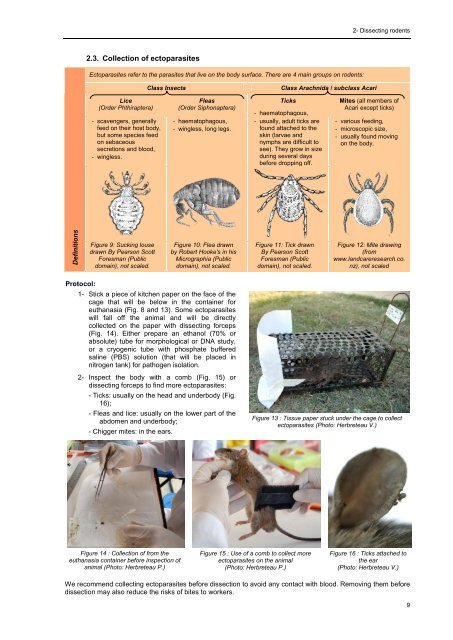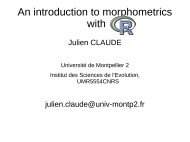Protocols for field and laboratory rodent studies - HAL
Protocols for field and laboratory rodent studies - HAL
Protocols for field and laboratory rodent studies - HAL
Create successful ePaper yourself
Turn your PDF publications into a flip-book with our unique Google optimized e-Paper software.
Definitions2- Dissecting <strong>rodent</strong>s2.3. Collection of ectoparasitesEctoparasites refer to the parasites that live on the body surface. There are 4 main groups on <strong>rodent</strong>s:Class InsectaClass Arachnida / subclass AcariLice(Order Phthiraptera)- scavengers, generallyfeed on their host body,but some species feedon sebaceoussecretions <strong>and</strong> blood,- wingless.Fleas(Order Siphonaptera)- haematophagous,- wingless, long legs.Ticks- haematophagous,- usually, adult ticks arefound attached to theskin (larvae <strong>and</strong>nymphs are difficult tosee). They grow in sizeduring several daysbe<strong>for</strong>e dropping off.Mites (all members ofAcari except ticks)- various feeding,- microscopic size,- usually found movingon the body.Figure 9: Sucking lousedrawn By Pearson ScottForesman (Publicdomain), not scaled.Figure 10: Flea drawnby Robert Hooke's in hisMicrographia (Publicdomain), not scaled.Figure 11: Tick drawnBy Pearson ScottForesman (Publicdomain), not scaled.Figure 12: Mite drawing(fromwww.l<strong>and</strong>careresearch.co.nz), not scaledProtocol:1- Stick a piece of kitchen paper on the face of thecage that will be below in the container <strong>for</strong>euthanasia (Fig. 8 <strong>and</strong> 13). Some ectoparasiteswill fall off the animal <strong>and</strong> will be directlycollected on the paper with dissecting <strong>for</strong>ceps(Fig. 14). Either prepare an ethanol (70% orabsolute) tube <strong>for</strong> morphological or DNA study,or a cryogenic tube with phosphate bufferedsaline (PBS) solution (that will be placed innitrogen tank) <strong>for</strong> pathogen isolation.2- Inspect the body with a comb (Fig. 15) ordissecting <strong>for</strong>ceps to find more ectoparasites:- Ticks: usually on the head <strong>and</strong> underbody (Fig.16);- Fleas <strong>and</strong> lice: usually on the lower part of theabdomen <strong>and</strong> underbody;- Chigger mites: in the ears.Figure 13 : Tissue paper stuck under the cage to collectectoparasites (Photo: Herbreteau V.)Figure 14 : Collection of from theeuthanasia container be<strong>for</strong>e inspection ofanimal (Photo: Herbreteau P.)Figure 15 : Use of a comb to collect moreectoparasites on the animal(Photo: Herbreteau P.)Figure 16 : Ticks attached tothe ear(Photo: Herbreteau V.)We recommend collecting ectoparasites be<strong>for</strong>e dissection to avoid any contact with blood. Removing them be<strong>for</strong>edissection may also reduce the risks of bites to workers.9



